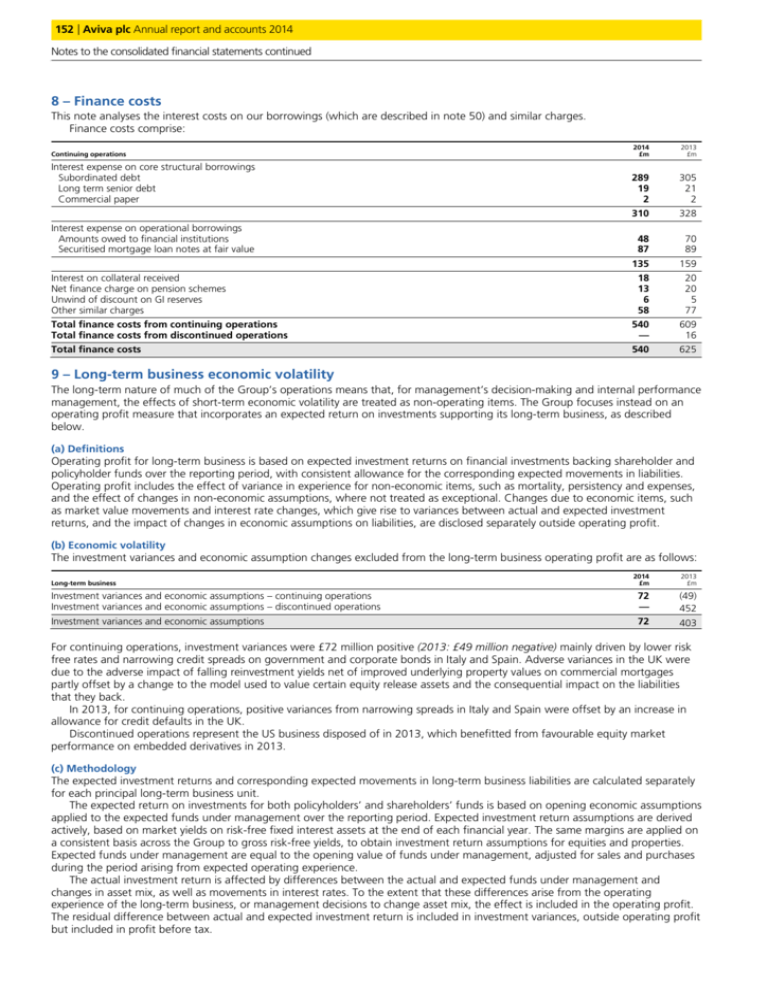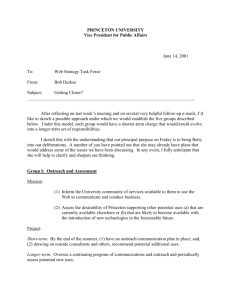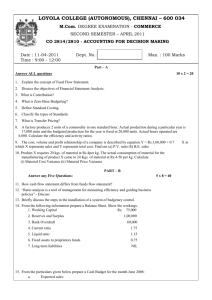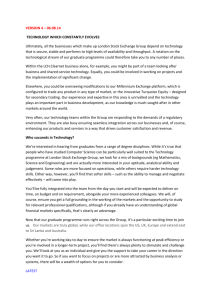Long-term business economic volatility
advertisement

152 | Aviva plc Annual report 152 report and and accounts accounts 2014 2014 Notes to the consolidated financial statements continued 8 – Finance costs This note analyses the interest costs on our borrowings (which are described in note 50) and similar charges. Finance costs comprise: Continuing operations 2014 £m 2013 £m Interest expense on core structural borrowings Subordinated debt Long term senior debt Commercial paper 289 19 2 305 21 2 310 328 48 87 70 89 135 159 18 13 6 58 20 20 5 77 Total finance costs from continuing operations Total finance costs from discontinued operations 540 — 609 16 Total finance costs 540 625 Interest expense on operational borrowings Amounts owed to financial institutions Securitised mortgage loan notes at fair value Interest on collateral received Net finance charge on pension schemes Unwind of discount on GI reserves Other similar charges 9 – Long-term business economic volatility The long-term nature of much of the Group’s operations means that, for management’s decision-making and internal performance management, the effects of short-term economic volatility are treated as non-operating items. The Group focuses instead on an operating profit measure that incorporates an expected return on investments supporting its long-term business, as described below. (a) Definitions Operating profit for long-term business is based on expected investment returns on financial investments backing shareholder and policyholder funds over the reporting period, with consistent allowance for the corresponding expected movements in liabilities. Operating profit includes the effect of variance in experience for non-economic items, such as mortality, persistency and expenses, and the effect of changes in non-economic assumptions, where not treated as exceptional. Changes due to economic items, such as market value movements and interest rate changes, which give rise to variances between actual and expected investment returns, and the impact of changes in economic assumptions on liabilities, are disclosed separately outside operating profit. (b) Economic volatility The investment variances and economic assumption changes excluded from the long-term business operating profit are as follows: 2014 £m 2013 £m Investment variances and economic assumptions – continuing operations Investment variances and economic assumptions – discontinued operations 72 — (49) 452 Investment variances and economic assumptions 72 403 Long-term business For continuing operations, investment variances were £72 million positive (2013: £49 million negative) mainly driven by lower risk free rates and narrowing credit spreads on government and corporate bonds in Italy and Spain. Adverse variances in the UK were due to the adverse impact of falling reinvestment yields net of improved underlying property values on commercial mortgages partly offset by a change to the model used to value certain equity release assets and the consequential impact on the liabilities that they back. In 2013, for continuing operations, positive variances from narrowing spreads in Italy and Spain were offset by an increase in allowance for credit defaults in the UK. Discontinued operations represent the US business disposed of in 2013, which benefitted from favourable equity market performance on embedded derivatives in 2013. (c) Methodology The expected investment returns and corresponding expected movements in long-term business liabilities are calculated separately for each principal long-term business unit. The expected return on investments for both policyholders’ and shareholders’ funds is based on opening economic assumptions applied to the expected funds under management over the reporting period. Expected investment return assumptions are derived actively, based on market yields on risk-free fixed interest assets at the end of each financial year. The same margins are applied on a consistent basis across the Group to gross risk-free yields, to obtain investment return assumptions for equities and properties. Expected funds under management are equal to the opening value of funds under management, adjusted for sales and purchases during the period arising from expected operating experience. The actual investment return is affected by differences between the actual and expected funds under management and changes in asset mix, as well as movements in interest rates. To the extent that these differences arise from the operating experience of the long-term business, or management decisions to change asset mix, the effect is included in the operating profit. The residual difference between actual and expected investment return is included in investment variances, outside operating profit but included in profit before tax. Aviva plc plc Annual Annual report report and accounts 2014 | 153 Aviva 9 – Long-term business economic volatility continued The movement in liabilities included in operating profit reflects both the change in liabilities due to the expected return on investments and the impact of experience variances and assumption changes for non-economic items. The effect of differences between actual and expected economic experience on liabilities, and changes to economic assumptions used to value liabilities, are taken outside operating profit. For many types of long-term business, including unit-linked and with-profits funds, movements in asset values are offset by corresponding changes in liabilities, limiting the net impact on profit. For other long-term business the profit impact of economic volatility depends on the degree of matching of assets and liabilities, and exposure to financial options and guarantees. (d) Assumptions The expected rate of investment return is determined using consistent assumptions between operations, having regard to local economic and market forecasts of investment return and asset classification under IFRS. The principal assumptions underlying the calculation of the expected investment return for equities and properties are: Equities United Kingdom Eurozone Properties 2014 % 2013 % 2014 % 2013 % 6.6 5.7 5.4 5.1 5.1 4.2 3.9 3.6 10 – Longer-term investment return and economic assumption changes for non-long-term business For non-long-term business, the total investment income, including realised and unrealised gains, is split between a calculated longer-term return, which is included in operating profit, and short-term fluctuations from this, which are disclosed outside operating profit but are included in profit before tax. This note gives details of the longer-term return calculation and the relevant assumptions, as well as the economic assumption changes on our general insurance and health business. (a) The short-term fluctuations in investment return and economic assumption changes attributable to the non-long-term business result and reported outside operating profit were as follows: 2014 £m 2013 £m 261 (145) (336) 33 116 (303) Non-long-term business - Continuing operations 2014 £m 2013 £m Analysis of investment income: Net investment income Foreign exchange gains/losses and other charges 754 (8) 266 (35) 746 231 485 567 181 80 261 (243) (93) (336) 746 231 Non-long-term business Short-term fluctuations in investment return (see (b) below) – continuing operations Economic assumption changes – continuing operations (see (g) below) (b) The longer-term investment return and short-term fluctuation for continuing operations are as follows: Analysed between: Longer-term investment return, reported within operating profit Short-term fluctuation in investment return, reported outside operating profit General insurance and health Other operations1 1 For 2014 represents short-term fluctuations on assets backing non-long-term business in Group centre investments, including the centre hedging programme. For 2013 represents short-term fluctuations on assets backing non-longterm business in the France holding company and Group centre investments, including the centre hedging programme. (c) The longer-term investment return is calculated separately for each principal non-long-term business unit. In respect of equities and properties, the return is calculated by multiplying the opening market value of the investments, adjusted for sales and purchases during the year, by the longer-term rate of investment return. The longer-term rate of investment return is determined using consistent assumptions between operations, having regard to local economic and market forecasts of investment return. The allocated longer-term return for other investments is the actual income receivable for the year. Actual income and longer-term investment return both contain the amortisation of the discounts/premium arising on the acquisition of fixed income securities. For other operations, the longer-term return reflects assets backing non-long-term business held in Group centre investments, including the centre hedging programme. IFRS Financial statements The expected return on equities and properties is calculated by reference to the opening 10-year swap rate in the relevant currency plus an appropriate risk margin. These are the same assumptions as are used under MCEV principles to calculate the longer-term investment return for the Group’s long-term business. For fixed interest securities classified as fair value through profit or loss, the expected investment returns are based on average prospective yields for the actual assets held less an adjustment for credit risks; this includes an adjustment for credit risk on all eurozone sovereign debt. Where such securities are classified as available for sale, the expected investment return comprises the expected interest or dividend payments and amortisation of the premium or discount at purchase.







